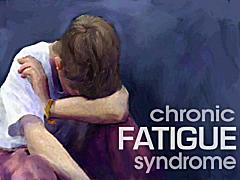Chronic fatigue syndrome, or CFS, is a condition that causes severe feelings of tiredness. It is not known how many people live with CFS, but one study in the US estimated the number to be between 75 and 265 people for every 100,000 in the general population. CFS is observed in women far more than in men. However, it may be that women are more likely to seek help and report their symptoms more often than men. The condition varies a great deal and can last several months, or it can persist for more than a decade.
symptoms may include
Poor concentration Short-term memory problems Joint and muscle pain Flu-like symptoms,Tender lymph nodes Headache Word-finding problems Impairment of speech Blurring,Sensitivity to light, sound or odours, Depression Diarrhoea and/or constipation, Irritability, Anxiety, Panic attacks, Personality changes, Mood swings, Dizziness, Sensitivity to heat and/or cold, Irregular heartbeat, Chest pains, Ringing in the ears, Muscle twitching.
Other factors known to increase a person’s risk of developing CFS include
An overworked, “stressed immune system caused by recent acute illness, chronic health problems, emotional factors (anxiety, depression), and/or poor nutrition. Exposure to certain environmental pollutants and contaminants.High levels of oxidative damage caused by free radical exposure. Uncontrolled, chronic inflammation within the body caused by toxicity, leaky gut, poor diet, autoimmunity or allergies. Extreme and/or prolonged emotional stress.
There are numerous disorders associated with CFS, eg Lupus, and Fybromyalgia,
Chronic Fatigue Syndrome and TCM
As with all diseases, the TCM approach to CFS is individualised to each patient; treatment begins with a detailed consultation in which the therapist discusses all aspects of a patient’s health, takes their pulse and looks at the tongue which can provide a wealth of information about the inner workings of the body. This enables the therapist to come to some understanding of how the patient’s Qi is impaired and how to redress their natural inner balance.
Often CFS patients are suffering from what is known in TCM as a ‘Retained Pathogen’. This is an originally external pathogen which has invaded the body and is lurking inside. ‘Pathogen’ here means an energetic entity which blocks the free flow of Qi; this is something more subtle than the western concepts of bacteria or virus, although it may well come along with them. It is conceptualised by analogy with climatic factors; just as extreme weather inhibits natural processes outside, so pathogens have the same effect in the body.
The patient may or may not have experienced acute symptoms when the pathogen invaded, and although any symptoms will have abated, the pathogen has not been expelled. This might be due to not taking time to recover properly after the illness, to constitutional weakness, or to exposure to damaging climatic conditions. It may also be due to the use of antibiotics, which kill the bacteria but trap the pathogen.
This retained pathogen is typically ‘Damp’ and/or ‘Heat’. Damp in TCM refers to a build up of bodily fluids which are not metabolised and circulated properly. It causes heaviness, lethargy, poor concentration and dull headaches. It can easily interfere with the digestion, leading to symptoms such as bloating and weight gain. Damp is difficult to move – hence the chronic nature of CFS – and it often combines with Heat which can interfere with sleep patterns, and cause symptoms such as excess sweating and a sore throat.
In this situation treatment will aim to ‘drain’ Damp from the body and clear Heat if necessary. This will involve the use of acupuncture points specific to these tasks as well as herbal therapy if appropriate. Appropriate dietary choices will be encouraged; certain foods can help to clear Damp or Heat, whilst others can exacerbate the symptoms.
http://tlc.howstuffworks.com/family/how-to-treat-fatigue-with-traditional-chinese-medicine.htm
DOES DIET MATTER?
Diet can be a huge part of CFS. All aspects of the diet needs to be examined. This includes, food intolerance’s, nutritional deficiencies, poor eating habits, and weather nutrition and energy are being absorbed from the foods your eating.
EASY TIPS FOR PLANNING A HEALTHY D…:
Foods such as white bread, white pasta, white potatoes and rice are rated high on the glycemic index. When these types of food are eaten in abundance and often, they tend to elicit a state of hypoglycemia (low blood sugar). Symptoms of hypoglycemia include fatigue, moodiness and mental fogginess. Selecting lower glycemic index grains such as whole grains that have not been refined (e.g., kamut, spelt or 100 per cent whole wheat), sweet potatoes and brown rice will help to keep your energy up and weight down. As a general rule, check the nutrition facts label — a good bread will contain 2 to 3 grams of fibre per slice.
Not only is green tea loaded with antioxidants and a terrific addition to any weight-loss program, it also contains natural caffeine that fights fatigue, as it mimics the same feelings you get from coffee. Looking to quit or decrease your morning java? Turn to some delicious green tea to avoid coffee withdrawals and keep energy up.Eating the right amount of protein helps to balance blood sugar, which in turn avoids energy fluctuations. Optimal sources of protein are those that are lower in saturated fat, such as low-fat dairy products (yogurt, cottage cheese, low-fat cheese), chicken, fish, turkey, soy and egg whites. On average, men need approximately 5 to 7 ounces of protein per meal while women need approximately 4 to 6 ounces of protein per meal. For an approximate measurement technique, the palm of your hand (without fingers or thumb) is equivalent to 3 ounces of protein.When selecting your foods, try to make your plate look as colourful as a pack of Crayola markers. Nature is very wise and has made our healthiest food — loaded with nutrients and vitamins — bright and beautiful. Tomatoes, blueberries, raspberries, broccoli, sweet potatoes, carrots, oranges and spinach are just a few of the nutritional superstars that will leave you feeling full of life. iron There are two sources of iron in food:One is found in iron-enriched cereal, dark green leafy vegetables, beans, nuts, seeds and some dried fruit. The other is found in red meats.
TREATMENT
There are numerous causes to this condition. Some are not known. It is therefore imperitive to look at all aspects. Diet, Lifestyle, Nutrition Levels, Stress, food intolerances, etc
Depending on the results, a treatment plan will be advised for you. This may involve exclusion diet (for allergies / intolerances ) acupuncture / needle free acupuncture, Chinese herbal medicine, nutrition diet and lifestyle changes.
Any exclusion diet will be fully explained and include recommendations for alternative foods. All consultations are strictly private and by appointment
Joanne Mc Govern – Dip Ac., Lic Ac., Dip. Chinese Herbs, Dip. Nutritional Advisor, Dip Stress Management.



